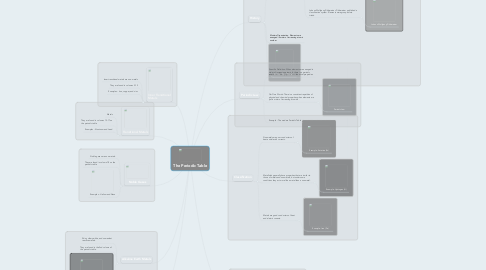The Periodic Table
by Brooklyn Hogan


1. Alkaline Earth Metals
1.1. Shiny, silvery-white, and somewhat reactive metals.
1.2. They are found in the 2nd column of the periodic table.
1.3. Examples - Magnesium and Calcium
2. Halogens
2.1. Halogens are non-metals.
2.2. They are found in columns 14-17 on the periodic table.
2.3. Examples - Carbon and Nitrogen
3. Noble Gases
3.1. Noble gases are non-metals.
3.2. They are found in column 18 on the periodic table
3.3. Examples - Helium and Neon
4. Transitional Metals
4.1. Metals
4.2. They are found in columns 13-17 on the periodic table
4.3. Examples - Aluminum and Lead
5. Inner Transitional Metals
5.1. Inner transitional metals are non-metals
5.2. They are found in columns 3-12
5.3. Examples - Iron, copper, and zinc
6. History
6.1. Two Scientist: Dmitri Mendeleeve and Johann Wolfgang Döbereiner
6.1.1. Dmitri Mendeleeve's impact on it: Mendeleeve provided gaps in his table for future elements and was able to predict the discovery of new elements with better accuracy because of this. He was also the first to come up with the periodic table.
6.1.1.1. Dmitiri Mendeleeve's
6.1.2. Johann Wolfgang Döbereiner: Döbereiner published a classification system. Elements were grouped into triads.
6.1.2.1. Johann Wolfgang Döbereiner
6.2. Modern Organization: Elements are arranged in order of increasing atomic number.
6.3. Periodic Table Elements
7. Periodic Law
7.1. Scientific Definition: When elements are arranged in order of increasing atomic #, there is a periodic repetition of their physical and chemical properties.
7.2. Our Own Words: There is a consistent repetition of physical and chemical properties when elements are put in order of increasing atomic #.
7.2.1. Periodic Law
7.3. Example - The modern Periodic Table
8. Classification
8.1. Nonmetals are poor conductors of heat and electric currents.
8.1.1. Example: Astatine (At)
8.2. Metalloids generally have properties that are similar to those of metals and nonmetals, but under some conditions they act more like a metal than a nonmetal.
8.2.1. Example: Hydrogen (H)
8.3. Metals are good conductors of heat and electric currents.
8.3.1. Example: Iron (Fe)
